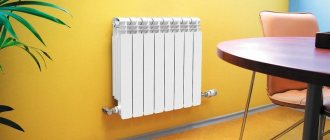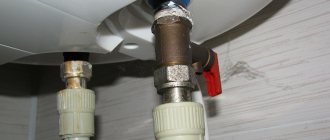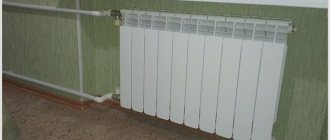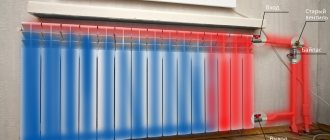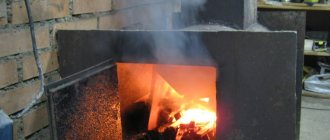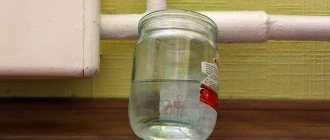In the off-season and especially in winter frosts, it is extremely important that the apartment is warm. But it often happens that in the summer the room is swelteringly hot, and in the cold season the residents freeze, despite the heating working properly.
Not everyone knows, but new and large batteries installed in an apartment do not at all guarantee that the room will have a comfortable temperature. However, the corner (end) location of the apartment, which many try to avoid, is not at all a guarantee that the premises will be cold in the fall and winter, and stuffy and hot in the summer.
In order to avoid getting into trouble when purchasing housing in an apartment building, you need to know some nuances. Will the apartment be warm, or will you freeze while staying in it? This depends on many factors and, first of all, on what floor the room is located.
Residents of lower floors will increase heating fees
Owners of apartments located on the first to fourth floors will pay more for heating. The authorities plan to introduce a new standard, according to which the cost of heat supply will depend on the number of floors. The increase in tariffs will be especially significant for owners of apartments located from the first to the fourth floor. As Boris Gladkikh, a member of the State Duma Committee on Energy, said, the change should come into force in 2020. The implementation of the initiative was supposed to take place three years ago, however, the Ministry of Construction achieved a postponement, writes Parlamentskaya Gazeta. According to the deputy, the issue should be transferred to the regional authorities so that they can decide how appropriate it is to change tariffs.
No duplicates found
Then I ask that a standard be introduced for deputies, according to which the cost of heating their apartment or place of residence will depend on their income.
For example, a deputy earns 45 million rubles a month - 9 million for heating, please pay.
He doesn't make money. He has a talented wife and children.
It’s always colder on the first floors, they will be heated more strongly with some kind of mokar (of course not), it turns out that people whose house is colder will be forced to pay “significantly more” than those whose house is warmer?! How the hell does this work, what the fuck is the point?!
Well, they think so. hot water for heating rises from below, heats the first floors, cools down, reaches the upper floors, goes down and runs into the boiler room. The process is repeated. therefore, the first floors receive all the heat at once, and the upper floors receive it as the remaining floors warm up.
The funny thing is that now in many houses hot water comes from top to bottom.
filling can be either top or bottom)
Perhaps I'm not arguing. I just expressed the thought of how those who write such innovations think
I live on the 21st floor and my radiators are an order of magnitude colder than those of my neighbors below. I don't know why, but it's a fact.
“An order of magnitude” means 10 (ten) times.
Are you still confident in your words?
I may have formulated it incorrectly, but the temperature of the neighbors below is noticeably higher during the heating season; we, upstairs, are sometimes so stupid that we wear sweaters and warm socks.
Have you checked the apartment with a thermal imager?
A specialist with a device can be called in inexpensively to draw up a heat map of the room - you can immediately see where the leaks are. where the wall is under-insulated, where the hidden temperature bridge is hidden.
This does not apply to the temperature of the radiators themselves, of course.
Many people have this in their entrances. There were problems due to the external seams, but then they called climbers, they repaired everything, but it didn’t help. We thought it was a double-glazed window, went to Leroy, bought everything we could use to glue the windows, it didn’t help. The pipes leading to the radiator are sometimes barely warm, but the neighbors, if you take the riser (or whatever this pipe is called that goes to the radiator) and hold your hand a little, there is a noticeable heat. It's noticeable without instruments.
Thank you, dear ones, for what we could do without such authorities...
And on what basis? And how many floors should the house be? Or will it be the same in five-story buildings?
They just can’t get enough of it, they are looking for ways to fleece the population.
Stupid populist statement. Such differentiated changes are 100% based on something, on some kind of research. The changes are painfully clear and unexpected. If they wanted to rip it off, they would stupidly install heating for all 10 of them. The only question is why the article kept silent about the reasons? Hype? Srach? Throw in? The source is frankly like that.
Try to think first rather than emotion.
what to think about? About the fact that the imbalance of the heating system in an apartment building is the concern of the management company, and not the residents of the lower floors?
So the point is that on the lower floors they receive more heat from the heating system? If so, then of course it’s nonsense. They themselves suffer from this: who opens the windows, who installs thermostats on the pipes. On the contrary, we should take less from the upper floors. They are extra. expenses have to be borne in case of heating with your own means.
Those floors that are closer to the supply line receive more heat - depending on the type of “filling”; if the coolant is supplied from bottom to top, the bottom is warmer, if from top to bottom, the top is warmer. But with normal balancing of the system, these differences are insignificant, and all floors are heated evenly.
So even this does not explain the logic of the proposal voiced)
Although, I tried to search and did not find any draft standards for heat consumption that would take into account the number of floors when calculating tariffs in one building, only different coefficients for houses of different number of floors - that is, 4-5-story buildings will pay more for them than 10-story buildings, and not different tariffs for apartments in the same building. So, suspicions arose that somewhere a journalist was raped again) Although, maybe I was looking poorly.
source
Types of radiators
The properties of the equipment and its ability to withstand negative phenomena depend primarily on the type of material.
Cast iron
A Soviet classic, familiar to every resident of high-rise buildings, because they were everywhere. They often meet even now. Bulky structures that have to be painted regularly to maintain a decent appearance.
And yet, many homeowners are in no hurry to part with old cast iron products for central heating and buy new models that are on the market. Before revealing the secret of such popularity, let's name their disadvantages:
- heaviness - it will take a lot of effort to bring in such a colossus. In addition, it is unlikely that you will be able to install it yourself;
- cast iron is fragile, which is why it does not always withstand strong water hammer;
- high price.
As you can see, there are not many disadvantages. But the advantages of cast iron samples are presented in abundance:
- serve up to 50 years;
- copes well with pressure up to 12 atmospheres (which is often more than enough);
- keep warm for a long time;
- please with efficient heat transfer;
- almost do not rust.
Such devices today are produced not only in the usual design. There are simply stunningly beautiful specimens that fit perfectly into the retro style, as well as quite modern, laconic forms.
To prevent the surface from having to be repainted regularly, a protective paint is applied to it, which does not have to be renewed.
Steel
They look beautiful and are inexpensive. Another positive aspect is the low weight and productive heat output. There are panel and tubular steel radiators.
Panel specimens look like two plates, between which water passes in steel contours. They fit perfectly into the interior as they look very presentable.
Tubular ones consist of several parts welded together and are similar to classic batteries (though their shapes are much more varied). As a rule, they are more expensive than panel ones.
Everything would be fine, but this option is not suitable for an apartment: such products can withstand no more than 10 atmospheres, and if this value is exceeded, they can burst and leak. In addition, without filling with liquid, they often begin to rust.
Aluminum
Light weight and reasonable price. This is the main reason for buying aluminum items. They have a better heat transfer coefficient and can last from 15 to 25 years, but only under conditions of constant low pressure and good quality media. But, as we remember, a centralized system cannot satisfy these requests.
They cannot withstand high pressure and leak. Such structures are also sensitive to water quality and are destroyed by a chemical reaction with the release of oxygen. So, alas, it is better for residents of high-rise buildings to refuse them.
Bimetallic
Consists of an aluminum casing and an internal part made of steel or copper. They can easily withstand temperatures up to 130 degrees and pressures up to 30 atmospheres.
The enamel coating provides an aesthetic appearance: such a device will easily fit into any environment. They are also treated inside and outside with anti-corrosion agents, which keeps them intact for a long time.
There are two types of such radiators.
- Sectional – you can add or reduce the number of segments.
- Monolithic - capable of withstanding pressure up to 100 atm, and therefore are characterized by a large margin of safety.
It is this type that is recommended to be chosen for an apartment building, as it is the most reliable. But the cost of such models is higher than others.
Copper
A rare guest in our stores. This is explained by the high cost of the metal. Although in operation they show themselves to be quite acceptable:
- quickly heat the room, thanks to increased efficiency;
- are not afraid of water hammer up to 25 atmospheres;
- resistant to high coolant temperatures;
- do not need painting or processing;
- do not rust and serve for a long time.
Among the weaknesses, additional requirements for the materials of supply lines and connecting elements can be noted: they must be made of copper or brass. Otherwise, the copper will react with other metal, leading to corrosion and destruction.
However, the design of such items is still quite specific and they cannot fit into any interior, which is clearly visible in the photo.
Difference for low and apartment buildings
The heat energy requirement in a high-rise building is less than in a low-rise building. Warm air rises through the heating system, gradually warming up all floors and stays longer in a multi-story building. The lower the building, the faster the heat disappears. In this regard, the standards will be revised upward for 1-story, 2-story, and three-story buildings.
The decision to differentiate payments by number of floors and type of building is considered by the Ministry of Construction, taking into account the impact on the amount of payment for a Russian. Since payment growth is limited by established indices, it will not be significant. Proper implementation of new standards and rules will avoid losses for individual residents and utility services.
If you find an error, please select a piece of text and press Ctrl+Enter.
source
Changing the standard as it depends on the number of storeys
From 2022, the government will introduce new rules for heating fees. According to them, the heating tariff will take into account the number of floors of the building in which the apartment is located (how will heating payments change from 2020?). Find out from the text why lower floors pay more for heat and other nuances.
What does floor payment mean?
The new standards will be different for different premises, depending on their location, since the energy costs for heating them depend on several factors. Thus, heating a 24-story building per apartment turns out to be cheaper than, say, a 3-story building.
Floor-by-floor calculation of payment means the dependence of the heating tariff on the number of floors of the house; the fewer floors in an apartment building, the more expensive it is to heat it. The material from which the walls are built, the age of the house and the climate zone in which the housing is located are also taken into account.
How does different height of an apartment affect coolant consumption?
Let's consider why payment depends on the floor and why heating on the first (lower) floors is more expensive than on the last and other nuances of consumption:
- Regulatory documents stipulate the parameters that central heating must provide. To achieve them, a certain difference in fluid pressure in the pipes between the upper and lower floors must be ensured. With every meter of water rise, the pressure drops, so the amount of water pressure, and therefore the amount of heat, depends on the floor.
- The coolant flow also depends on the temperature difference at the inlet and outlet of the system. The higher the house, the greater this difference, and accordingly, the consumption also increases.
Features of central heating and requirements for radiators
A centralized heat supply system has some differences from an autonomous one, which are important to remember when choosing:
- the water entering the pipes is far from ideal: it contains various additives, salts, oxygen and rust;
- hydraulic shocks occur in the system - a sharp increase in pressure, often this occurs during the period when heating is turned on/off and during pressure testing;
- The temperature is also unstable - the batteries either barely warm or burn.
Based on these data, we can formulate an expanded list of required properties of thermal appliances:
- Radiators must withstand pressure 1.5 times higher than what happens in the system. In Soviet panel or brick five-story buildings it is 5–8 atmospheres, in new buildings 12–15.
- The metal must be resistant to corrosion or have a special coating on the inside so that no rust, scale or other troubles linger on the surface. It is good if the material does not react to the presence or absence of water in the system and to changes in temperature in the coolant.
- The thickness of the walls must be sufficient so that abrasive particles (such as rust or sand) do not thin them over time due to friction. Otherwise, a breakthrough cannot be avoided.
- High heat transfer will allow you to get your portion without losses due to poor conductivity.
- In addition to the functional load, this element also has an aesthetic one, so it is desirable that it harmoniously complement the decor and not spoil it.
